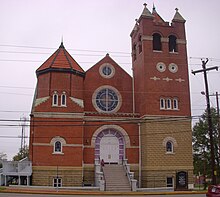First Baptist Church (Montgomery, Alabama)
| First Baptist Church | |
|---|---|

Front of the First Baptist Church
|
|
| Location | North Ripley Street, Montgomery, Alabama |
| Country | United States |
| Denomination | Baptist |
| Website | http://www.firstbaptistchurchmontgomery.com |
| History | |
| Founded | 1866 |
| Architecture | |
| Architect(s) | W.T. Bailey |
| Style | Romanesque Revival |
| Completed | 1910–1915 (present building) |
| Clergy | |
| Pastor(s) | E. Baxter Morris |
The First Baptist Church (also known as the Brick-A-Day Church) on North Ripley Street in Montgomery, Alabama, is a historic landmark. Founded in downtown Montgomery in 1867 as one of the first black churches in the area, it provided an alternative to the second-class treatment and discrimination African-Americans faced at the other First Baptist Church in the city.
In the first few decades after its establishment the First Baptist Church became one of the largest black churches in the South, growing from hundreds of parishioners to thousands. Almost a hundred years later, in the 1950s and 1960s, it was an important gathering place for activities related to the Civil Rights Movement, and became associated with the Montgomery bus boycott and the Freedom Rides of May 1961. The church was listed by the Alabama Historical Commission on the Alabama Register of Landmarks and Heritage on May 5, 2000.
The congregation first organized in 1866; early parishioners had worshiped during slavery at the other First Baptist Church in Montgomery, on Perry Street. Before the American Civil War, blacks were allowed only on the balcony of that church: "they were never allowed on the main floor of the sanctuary unless they were sweeping or mopping." In 1867, 700 African-American communicants had marched to an empty lot on the corner of Ripley Street and Columbus Street, declaring themselves the "First Baptist Church (Colored)" and founding what became "the first 'free Negro' institution in the city." The wooden building itself, which faced north to Columbus Street, was called the Columbus Street Baptist Church.
The first pastor was Nathan Ashby, who also became the first president of the Colored Baptist Convention in Alabama, founded in his church on December 17, 1868. Ashby retired in 1870, after being struck by paralysis. He was followed, briefly, by J.W. Stevens, and starting in 1871, James H. Foster was the pastor for twenty years. Foster is credited with increasing membership from a few hundred to several thousand; his successor, pastor Andrew Stokes, added even more.
...
Wikipedia
